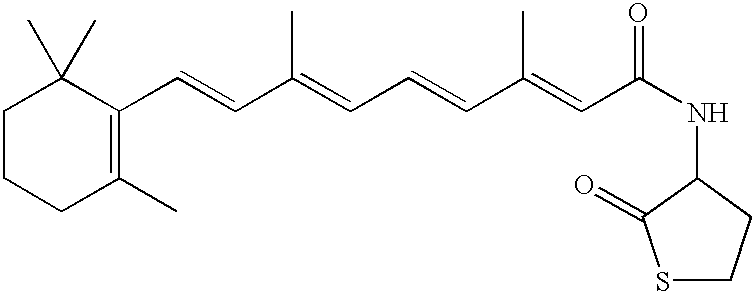Novel retinoid derivatives and methods for producing said compounds and anti-cancer pharmaceutical composition comprising said compounds
- Summary
- Abstract
- Description
- Claims
- Application Information
AI Technical Summary
Benefits of technology
Problems solved by technology
Method used
Image
Examples
example 1
[0125] (2E,4E,6E,8E)-[3,7-dimethyl-9-(2,6,6-trimethylcyclohex-1-enyl)-nona--2,4,6,8-tetraenoyl]-(2,4-dihydroxy)phenylamide (KCBG08)
[0126] A solution of EDCI (0.076 g, 0.39 mmol) and retinoic acid (0.10 g, 0.33 mmol) in anhydrous DMF (5 mL) was stirred at 0.degree. C. for 0.5 h. To this solution was added a solution of 4-amino resorcinol.HCl (0.063 g, 0.39 mmol) and DMAP (cat.) in anhydrous DMF (5 mL). The resulting mixture was stirred at room temperature for 4 h. The reaction mixture was diluted with EtOAc (30 mL), washed with H.sub.2O (2.times.30 mL) and concentrated. The crude product was purified by flash column chromatography on silica gel (EtOAc:hexane=1:4) to give (2E,4E,6E,8E)-[3,7-dimethyl-9-(2,6,6-trimethylcyclohex-1-enyl)-nona-2,4,6-,8-tetraenoyl]-(2,4-dihydroxy)phenylamide (KCBG08, 0.078 g, 58%) as a yellow solid.
example 2
[0127] (2E,4E,6E,8E)-[3,7-dimethyl-9-(2,6,6-trimethylcyclohex-1-enyl)-nona--2,4,6,8-tetraenoyl]-(2,4-dihydroxy)phenylamide (KCBG08)
[0128] A mixture of anhydrous DMF (2 mL) and SOCl.sub.2 (0.072 mL, 0.99 mmol) was stirred under argon for 1 h. To the mixture was added a solution of retinoic acid (0.10 g, 0.33 mmol) in anhydrous DMF (2 mL). After stirring at 0.degree. C. for 45 min, the clear deep red retinoyl chloride solution was added dropwise to a cooled solution distilled triethylamine (0.14 mL, 0.99 mmol) and 4-amino resorcinol.HCl (0.10 g, 0.66 mmol) in dry, degassed DMF (2 mL). The reaction was quenched with NH.sub.4Cl (aq.), extracted with EtOAc (30 mL). The extracts were washed with H.sub.2O (2.times.30 mL) and concentrated. The residue was purified by flash column chromatography on silica gel (EtOAc:hexane=1:4) to give KCBG08 (0.11 mg, 86%) as a yellow solid.
[0129] .sup.1H-NMR (200 MHz, CDCl.sub.3): .delta. 7.78 (br s, 1H, NH), 6.97 (dd, 1H, J=15.00), 6.76 (d, 1H, J=8.60, Ar...
example 3
[0130] (2,4-Dihydroxyphenyl)-carbamic acid benzyl ester (KCBG02)
[0131] To a cooled solution (0.degree. C.) of 4-amino resorcinol.HCl (1.0 g, 6.18 mmol) in H.sub.2O (10 mL) was added dropwise aq. NaOH (0.49 g, 12.3 mmol) in H.sub.2O (15 mL). To this mixture were added slowly Cbz-Cl (Carbobenzoxy chloride, 1.06 mL, 7.43 mmol) and NaOH (0.25 g) in H.sub.2O (5 mL). After stirring for 1 h at room temperature, the mixture was extracted with EtOAc (2.times.50 mL). The organic layer was dried over MgSO.sub.4 (10 g), filtrated and concentrated. The residue was purified by flash column chromatography on silica gel (EtOAc:hexane=1:5) to give (2,4-dihydroxyphenyl)-carbamic acid benzyl ester (KCBG02. 1.28 g, 80%).
[0132] .sup.1H-NMR (200 MHz, CDCl.sub.3): .delta. 8.96 (br s, 1H, OH), 8.46 (br s, 1H), 7.47 (d, 1H, NH), 7.33.about.7.41 (m, 5H), 6.45 (d, 1H, J=2.50), 6.33 (dd, 1H, J=8.64, 2.50), 5.17 (s, 2H).
PUM
 Login to View More
Login to View More Abstract
Description
Claims
Application Information
 Login to View More
Login to View More - R&D
- Intellectual Property
- Life Sciences
- Materials
- Tech Scout
- Unparalleled Data Quality
- Higher Quality Content
- 60% Fewer Hallucinations
Browse by: Latest US Patents, China's latest patents, Technical Efficacy Thesaurus, Application Domain, Technology Topic, Popular Technical Reports.
© 2025 PatSnap. All rights reserved.Legal|Privacy policy|Modern Slavery Act Transparency Statement|Sitemap|About US| Contact US: help@patsnap.com



